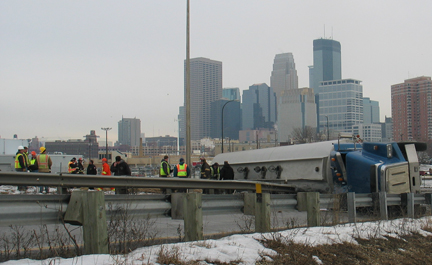|
By Craig Wilkins
After a gasoline tanker overturned as it approached Interstate 394 in Minneapolis, responders from Mn/DOT and other agencies responded in orderly waves to deal with a potentially dangerous situation.
State Patrol officers were the first to reach the scene; Mn/DOT’s Freeway Incident Response Safety Team crew units arrived just minutes later.

Kevin Kampa, a hazardous materials special with Freight and Commercial Vehicle Operations (at right) reviews action plans at the site with officials including Doug Thies, a Metro District safety administrator (in yellow hard hat), and Cathy Clark, acting Homeland Security Section director.
Photo by Kent Barnard |
They were quickly joined by the Minneapolis Fire Department, sheriff’s deputies and others focused on their specific but interlocking set of responsibilities.
The incident occurred on Jan. 9 at shortly after 9 a.m. causing numerous road and ramp closures. Full access to ramps and Interstate 394 was restored at 7:15 p.m.
Metro District maintenance crews came in right after traffic was detoured, bringing loads of sand to slow the spread of fuel leaking from the crash site.
Julie Todora and other FIRST driver quickly closed all access routes to the scene. They also shut down the mainline of Interstate 394 until the situation stabilized.
Response crews, she said, had to use extreme caution because of a possible explosion from gas fumes.
Todora said, for example, that recovery crews had to make sure their vehicles weren’t parked over manhole covers, storm sewer grates or other areas where gasoline fumes might collect and possibly ignite.
As she drove toward the scene, Todora said she focused on her part in closing access routes and preventing hazards that might result from the spill.
“We created a buffer around the site so that firefighters, hazardous materials specialists and others could do their jobs without distractions and as safely as possible,” she said.
Among those working inside the cordoned off area was Kevin Kampa, a hazardous materials specialist with Freight and Commercial Vehicles Operations.
Kampa teamed with the State Patrol, the fire department, the Metro District and other responders to mop up gasoline pooled at the crash site, transfer gas in the tanker to another truck and remove the damaged tanker from the area.

The crash of a gasoline tanker near downtown Minneapolis caused a traffic delay that lasted for several hours. The driver suffered only minor injuries. Photo by Kent Barnard |
Most of the tanker’s load, about 6,500 gallon of gas, poured into the city’s storm sewer system.
The tanker was wedged into the guard rail, Kampa said, making it necessary to remove any fuel still inside before it was moved.
Freeing the tanker from the guard rail, he said, might have ruptured the one undamaged fuel cell or caused a spark that could have ignited the fuel still inside the truck.
Doug Thies, a Metro District safety administrator, said the response was well-coordinated and recovered nearly 6,000 gallons of gasoline that entered the sewer system with only trace amounts detected in the river.
Responders lamented the damage to the environment, but expressed relief that no one was seriously injured or killed.
The tanker’s driver suffered minor injuries.
“We had a major traffic tangle for awhile there,” Todora said, “but it could have been a lot worse.” |



